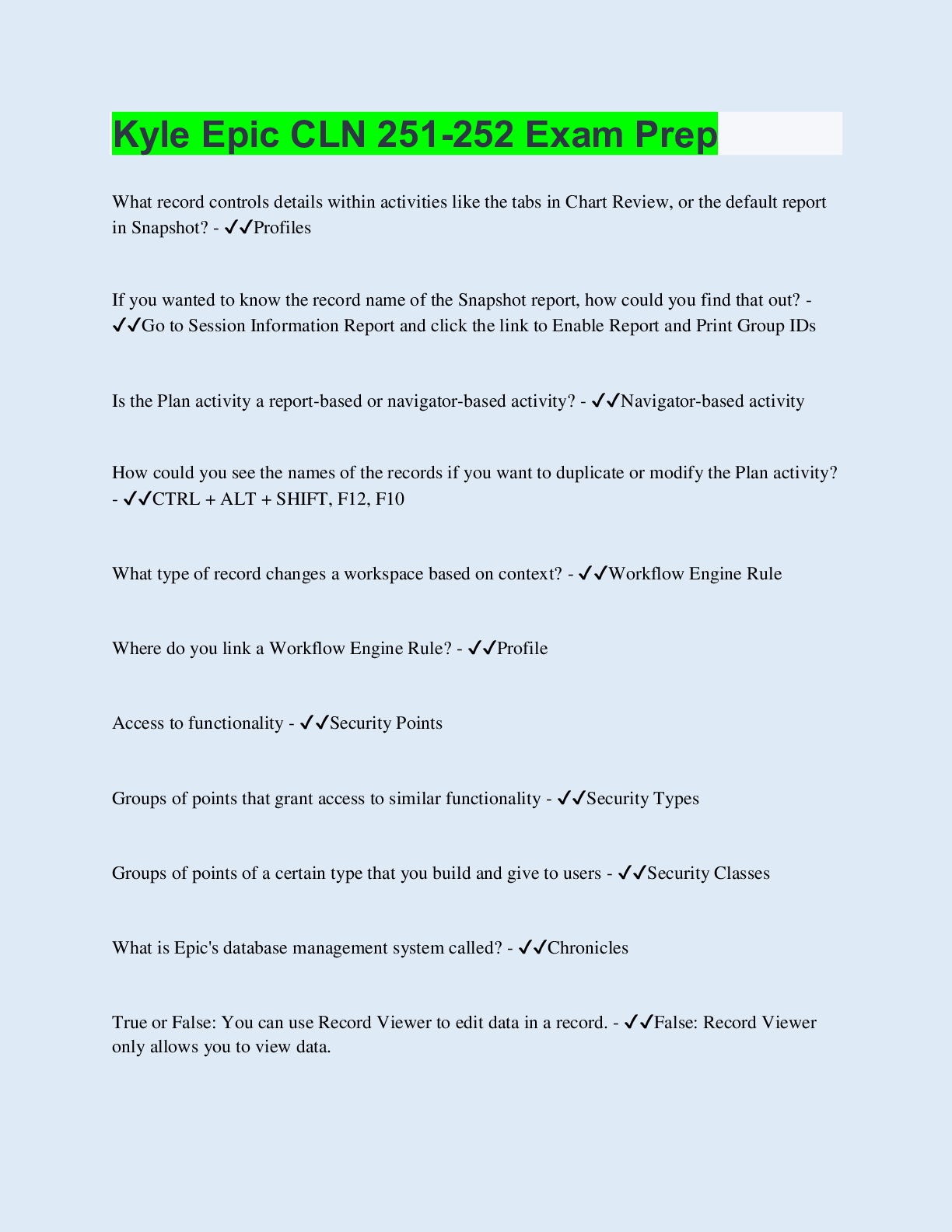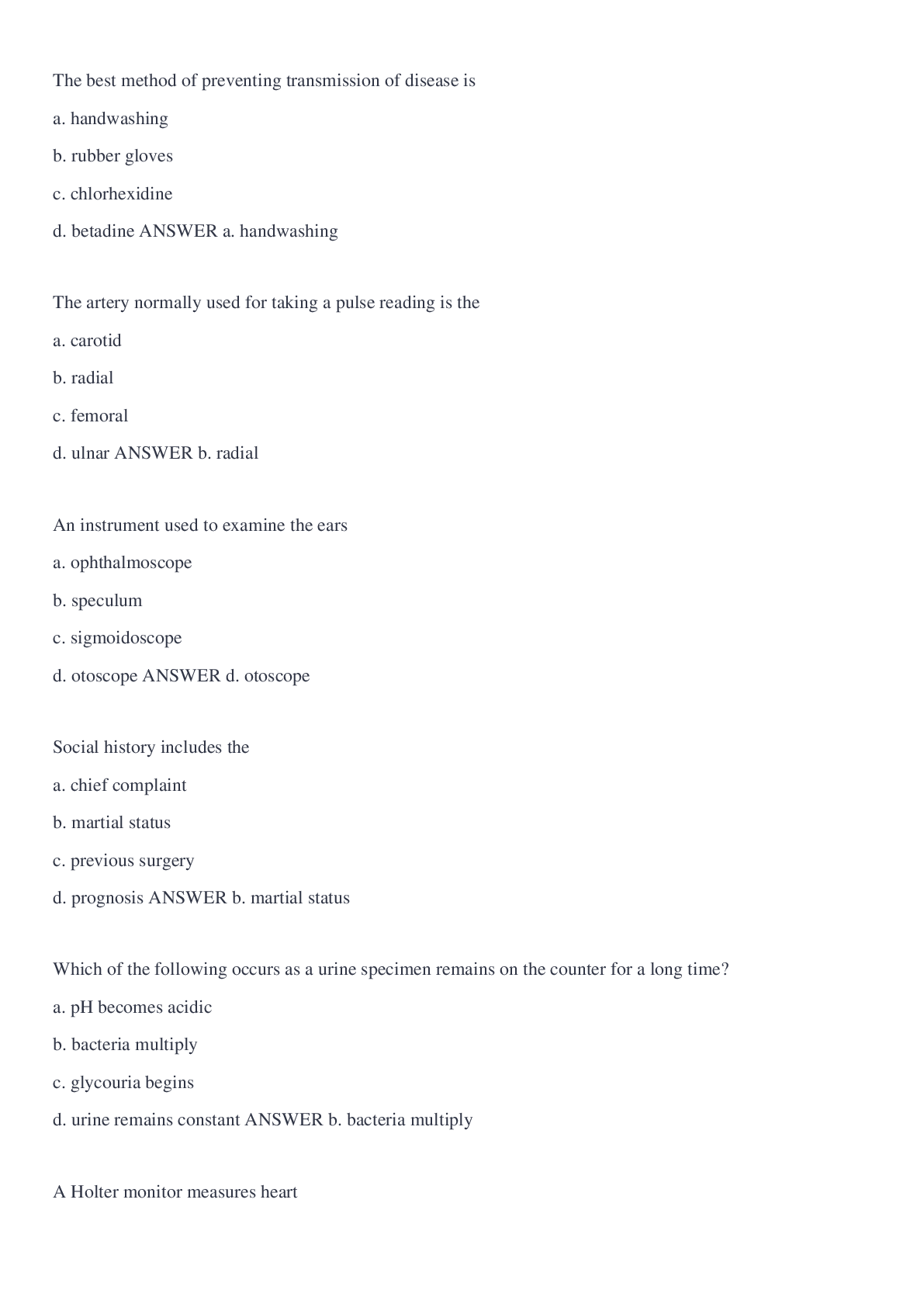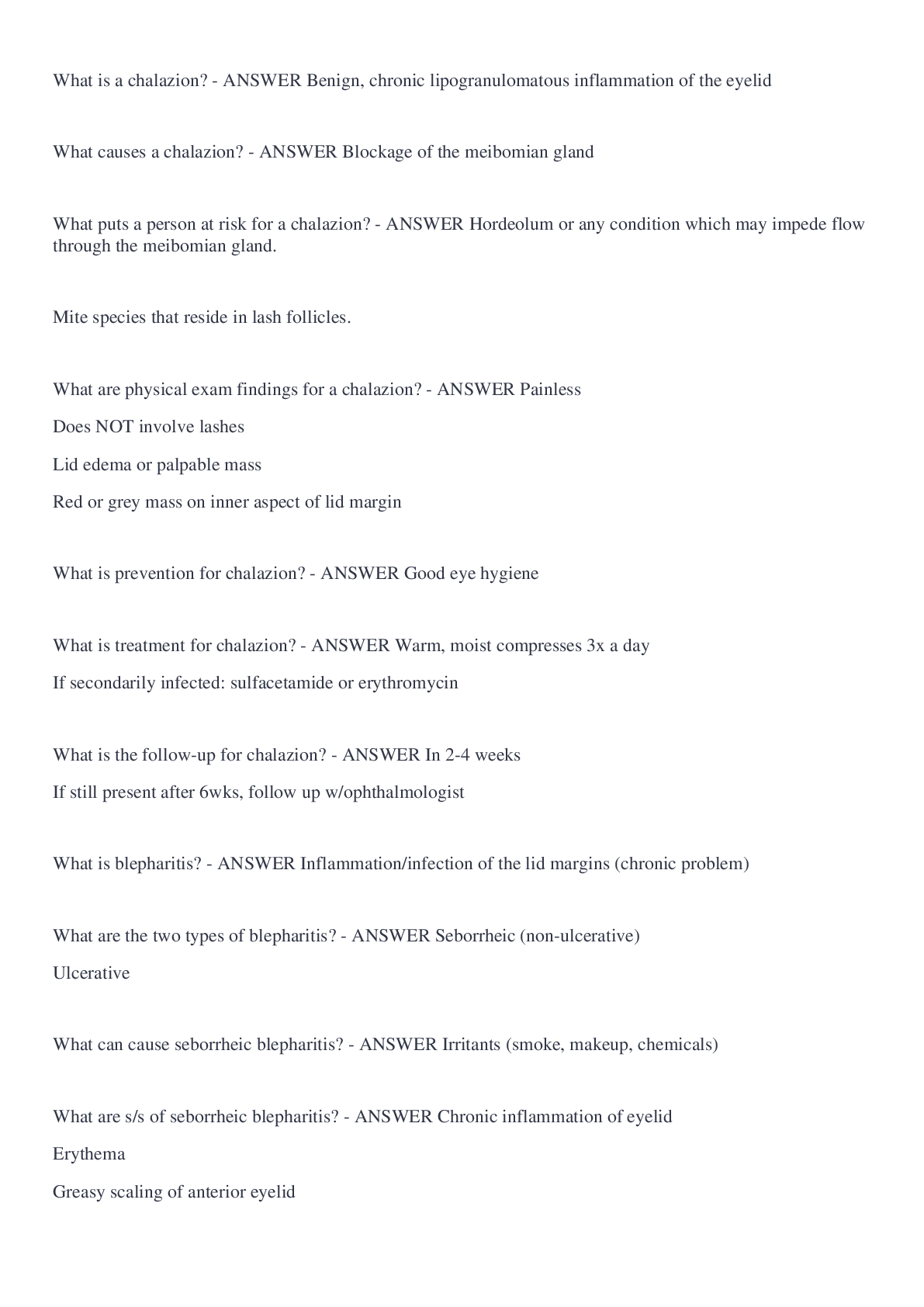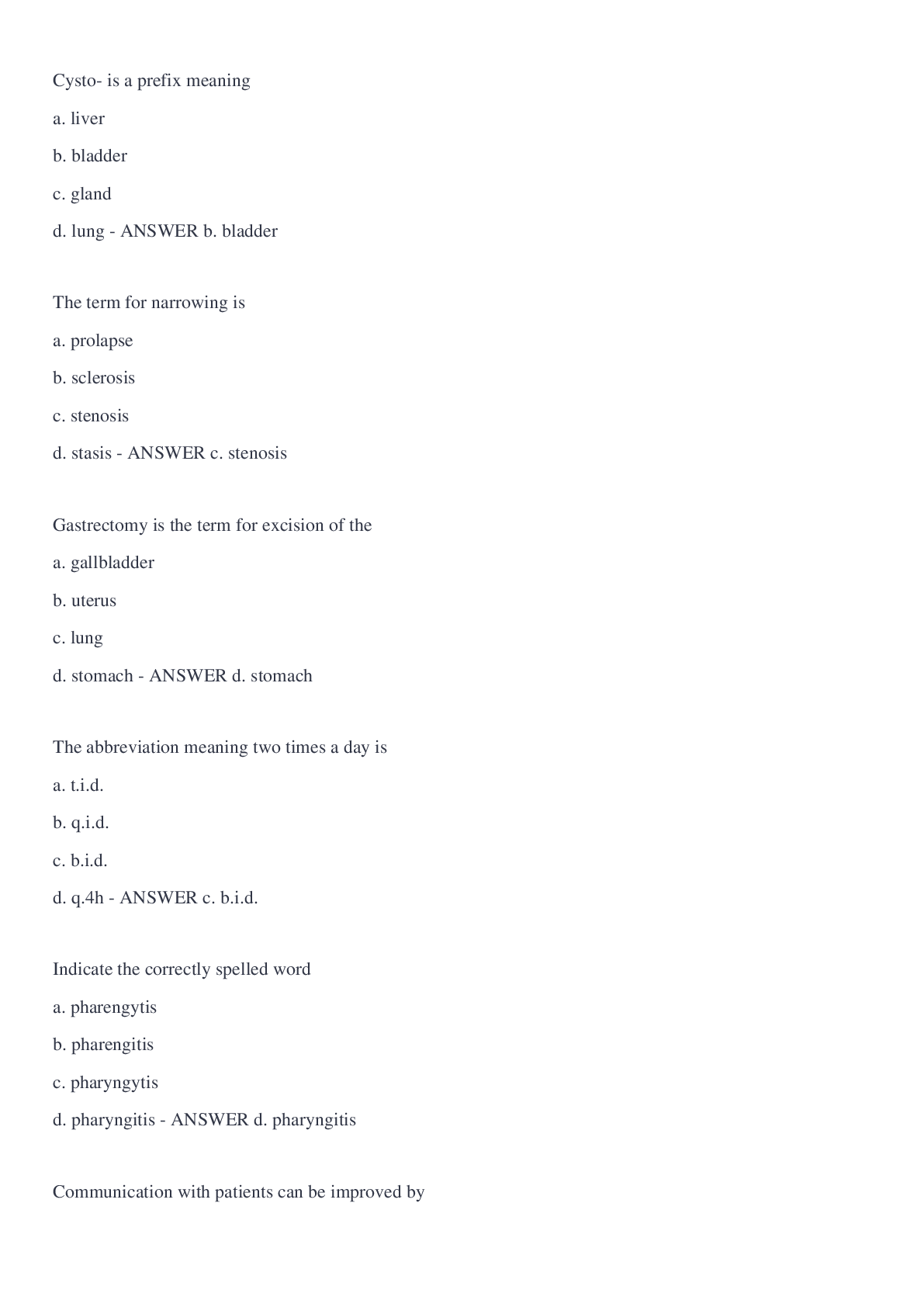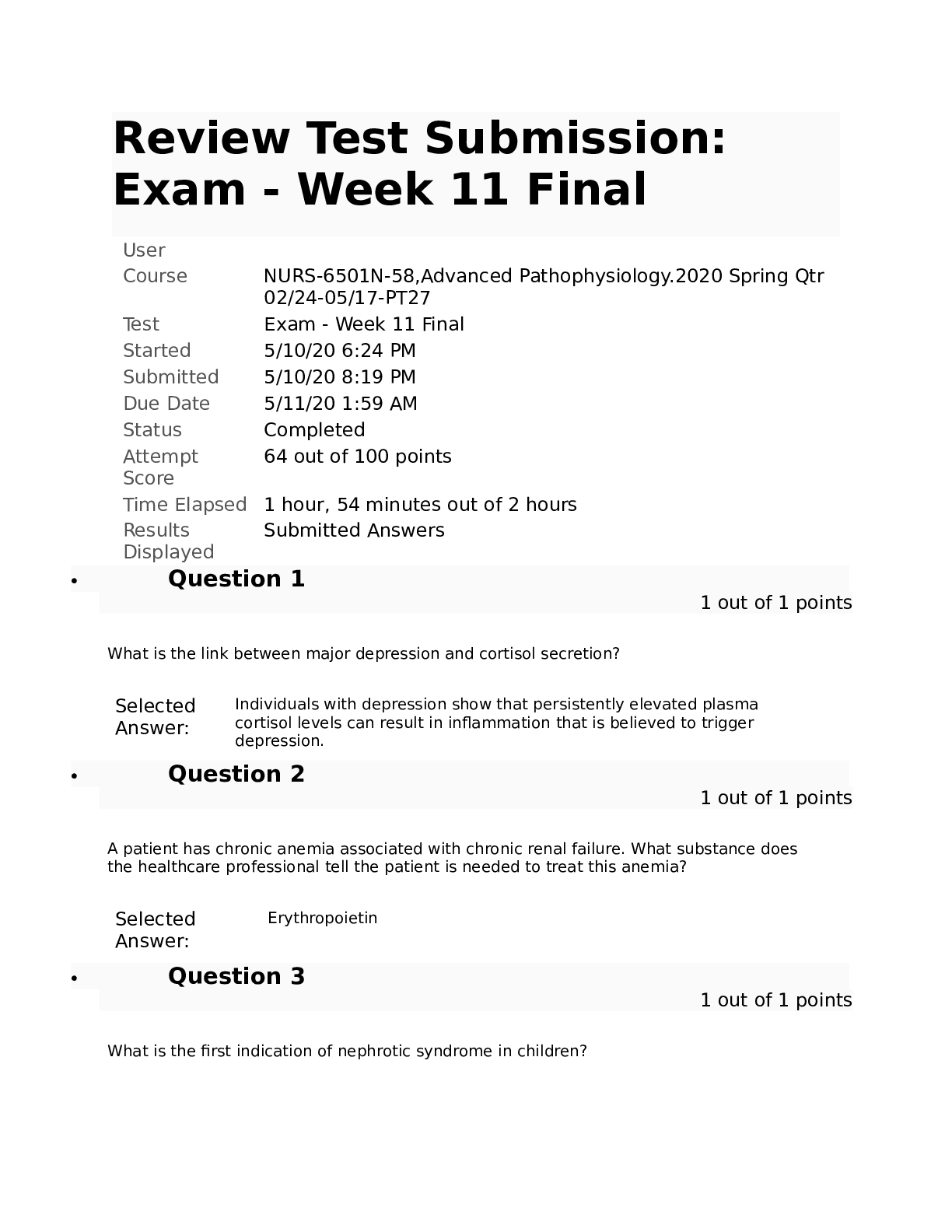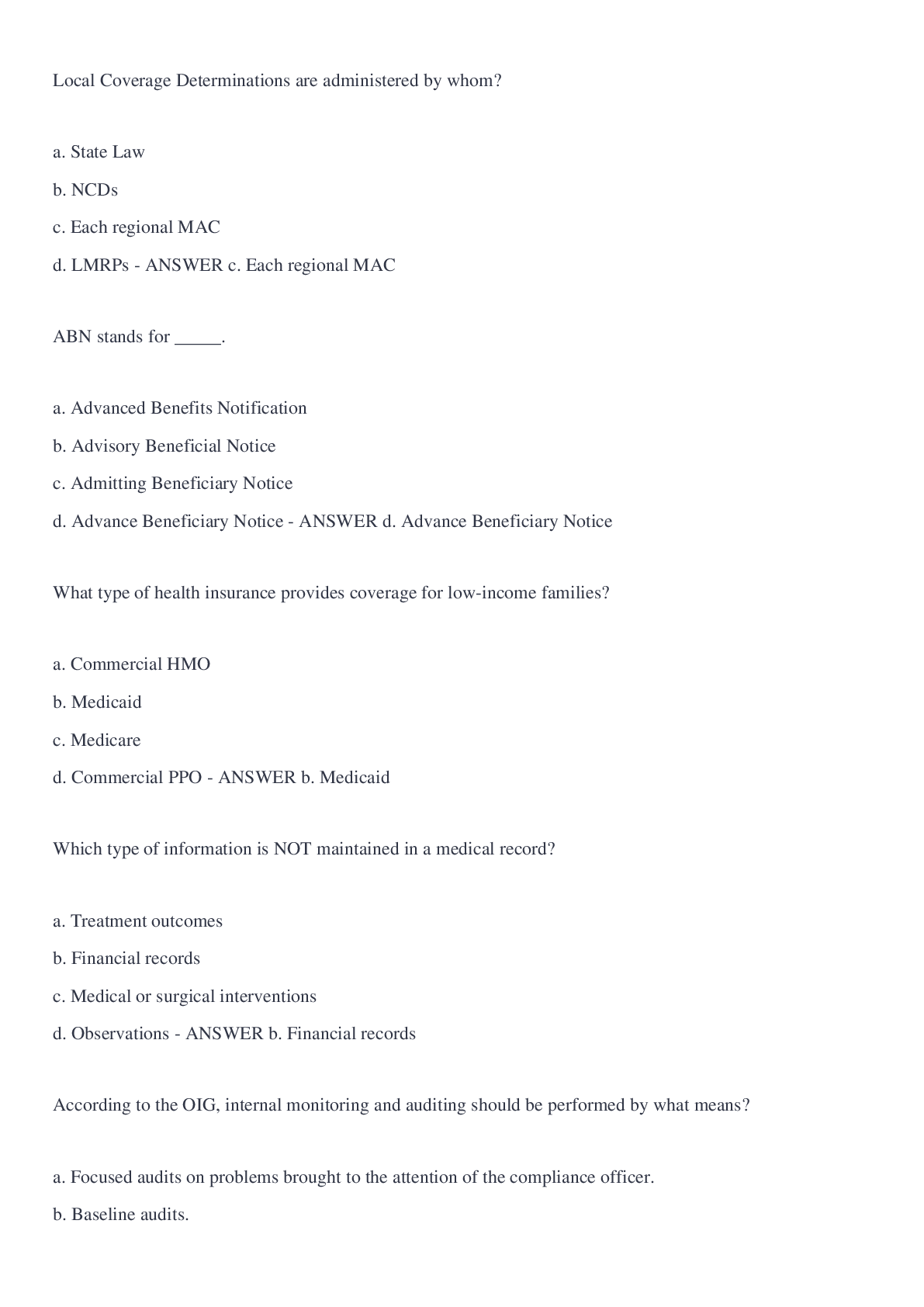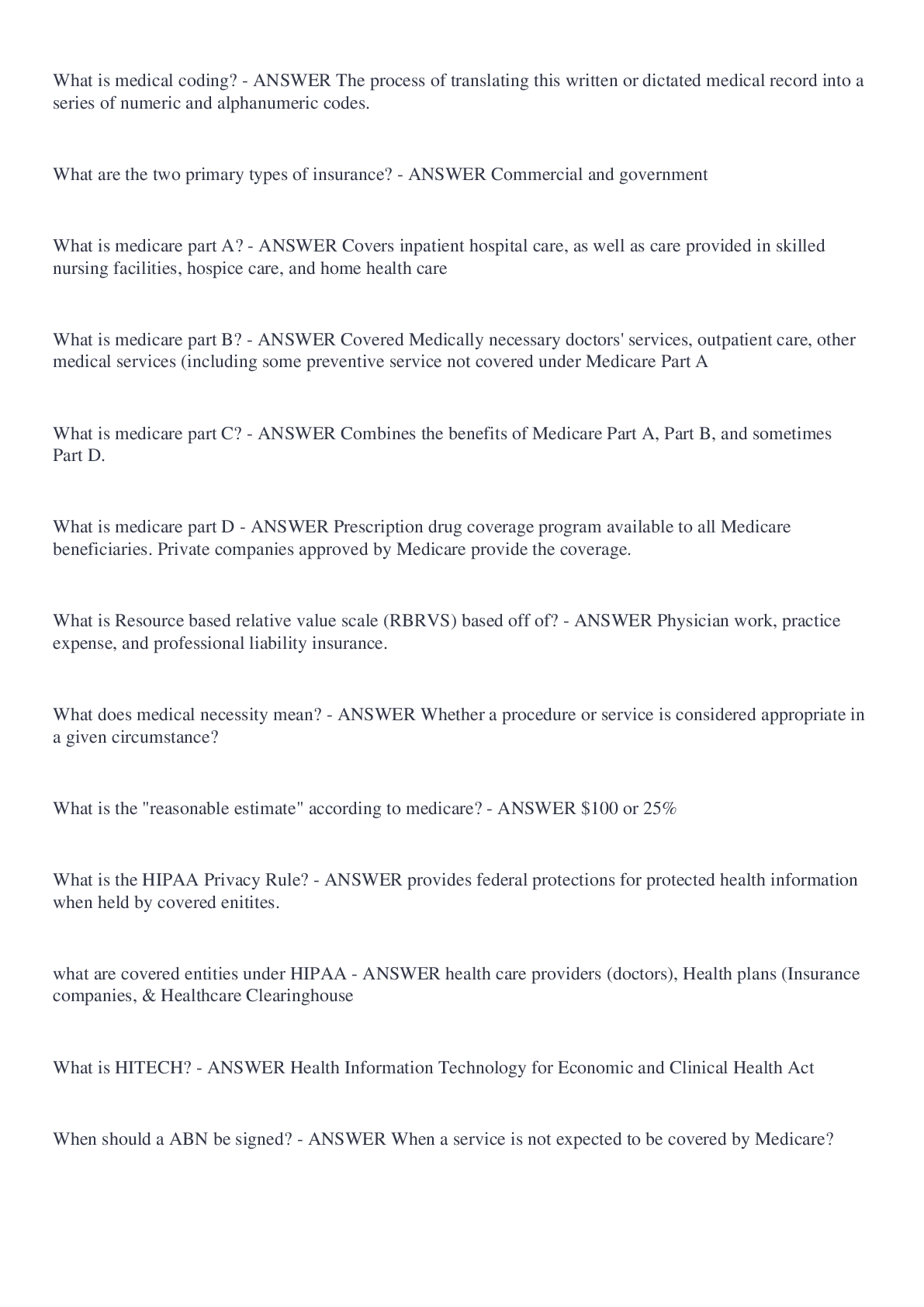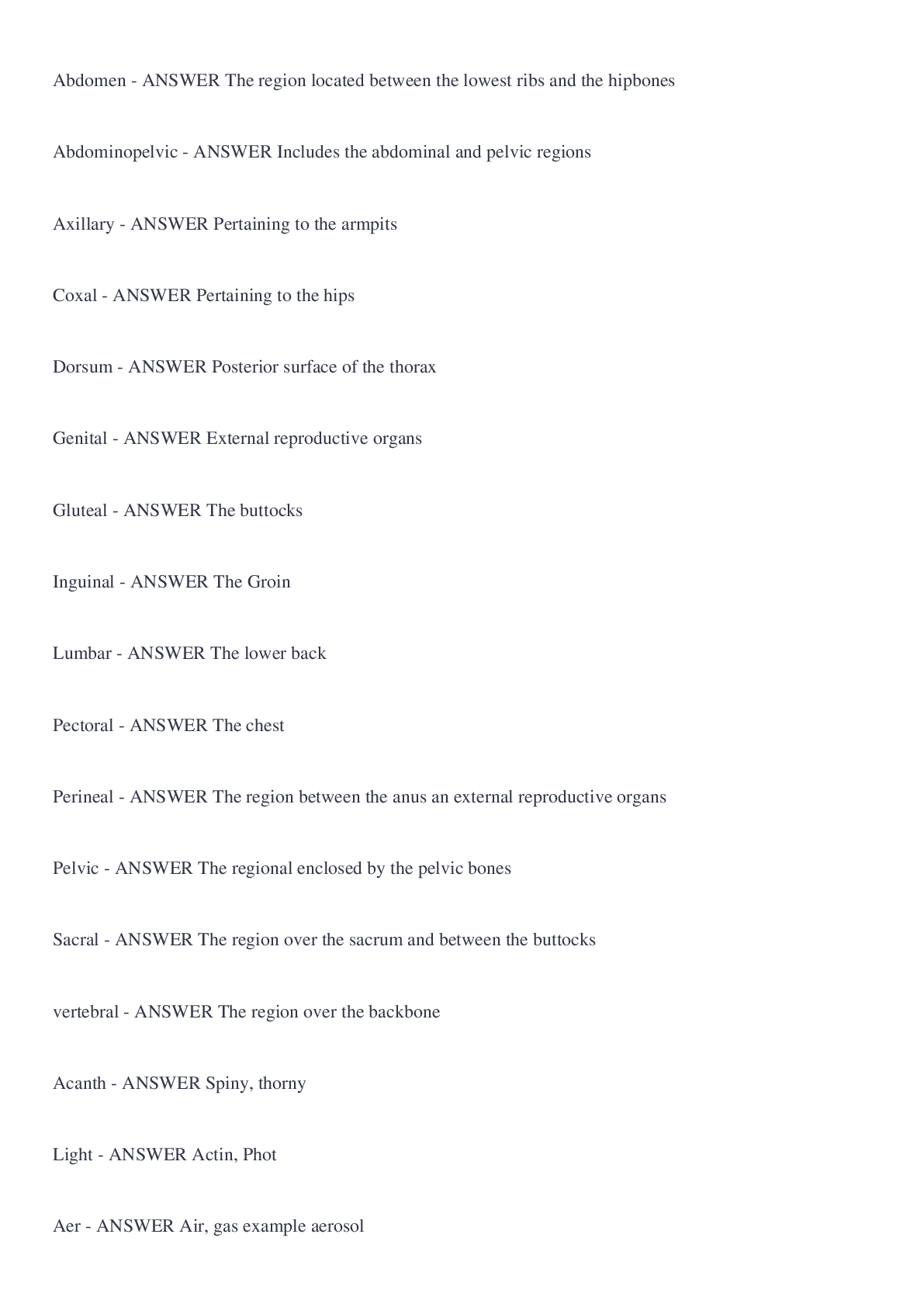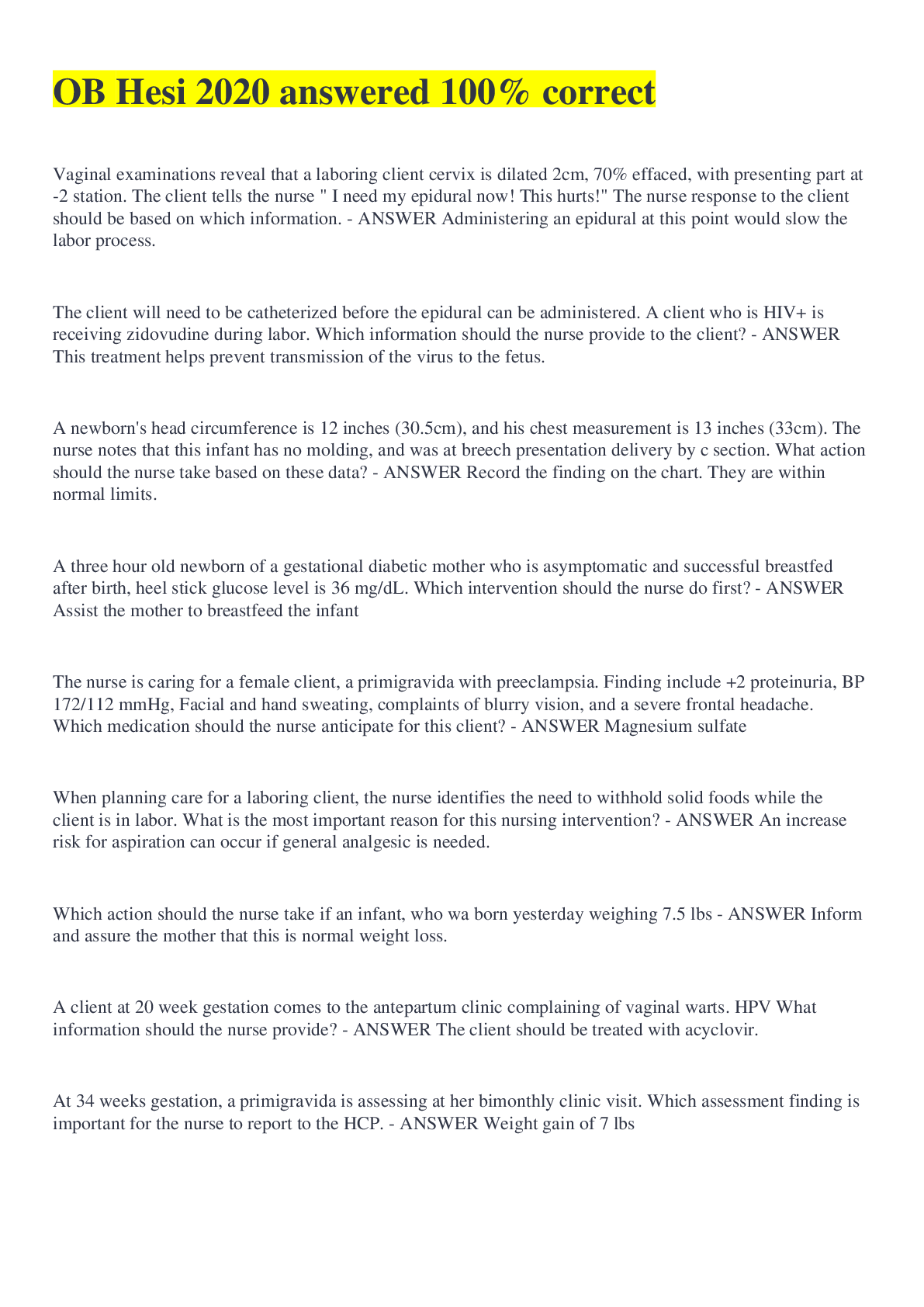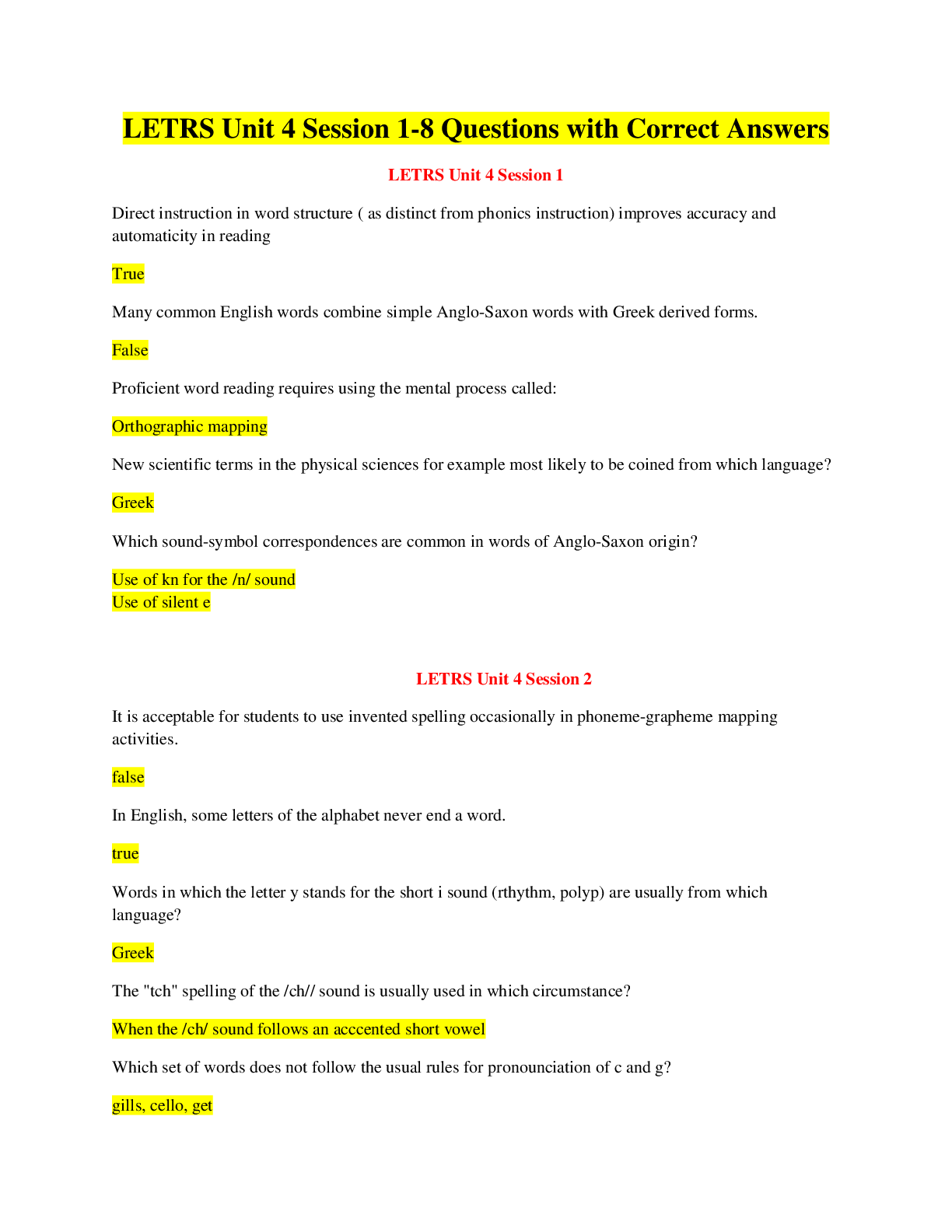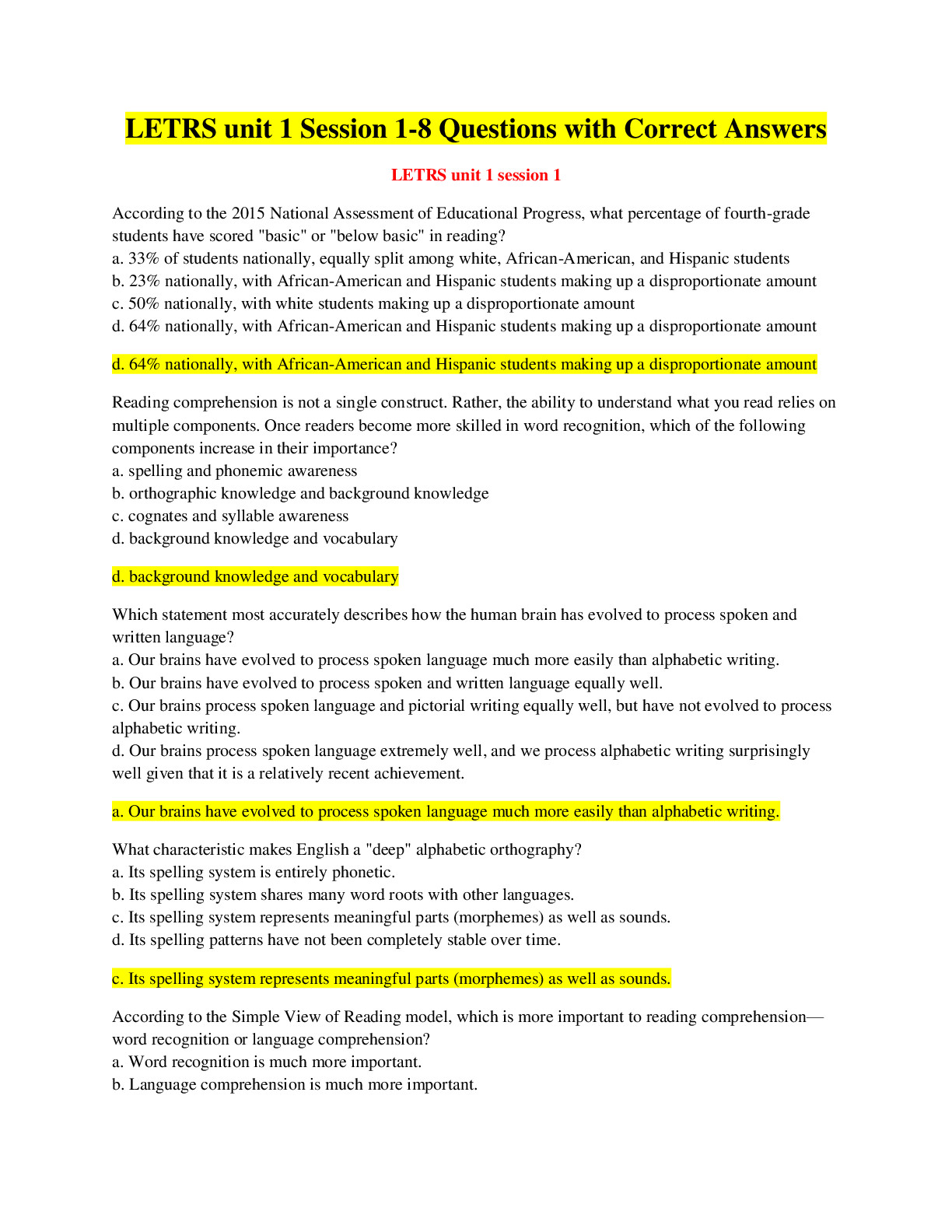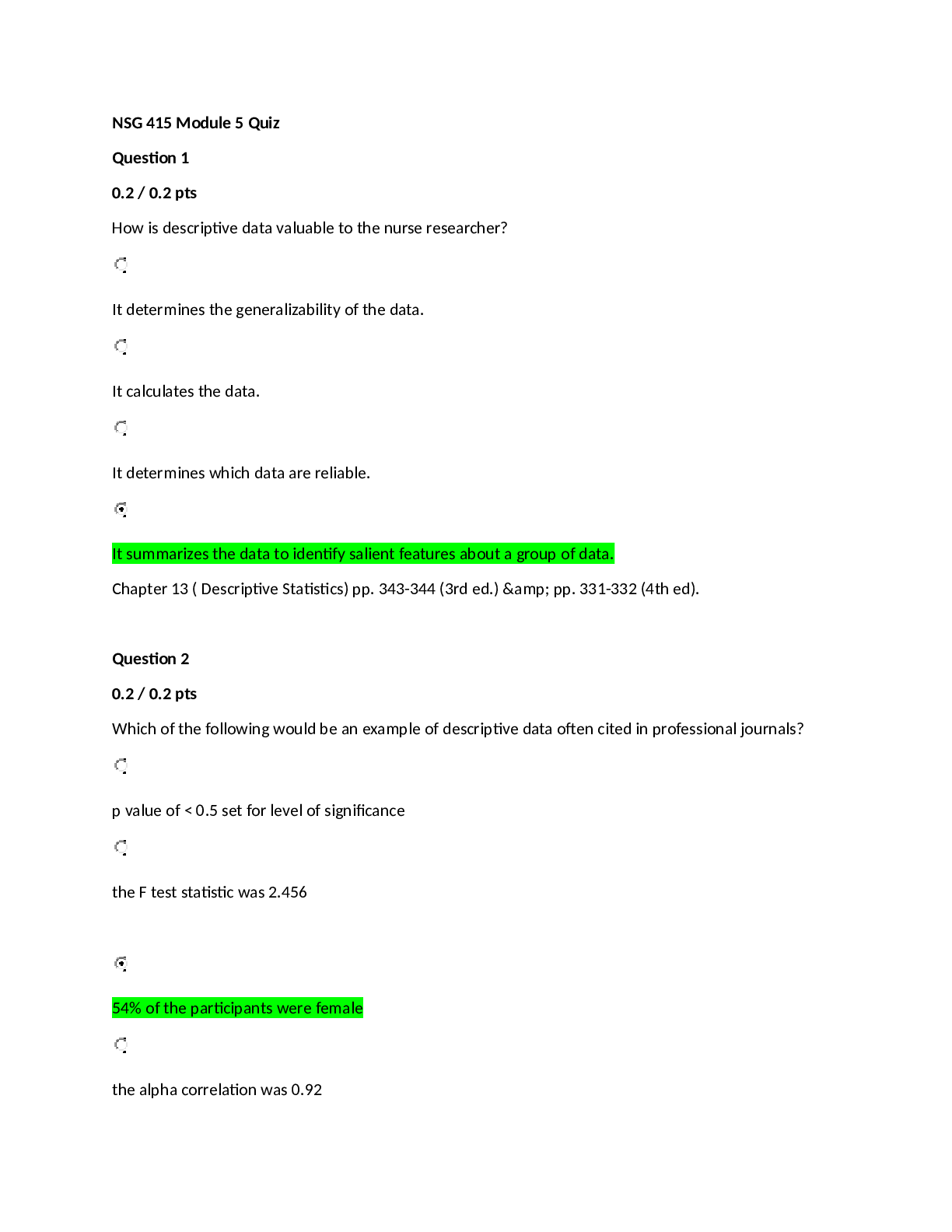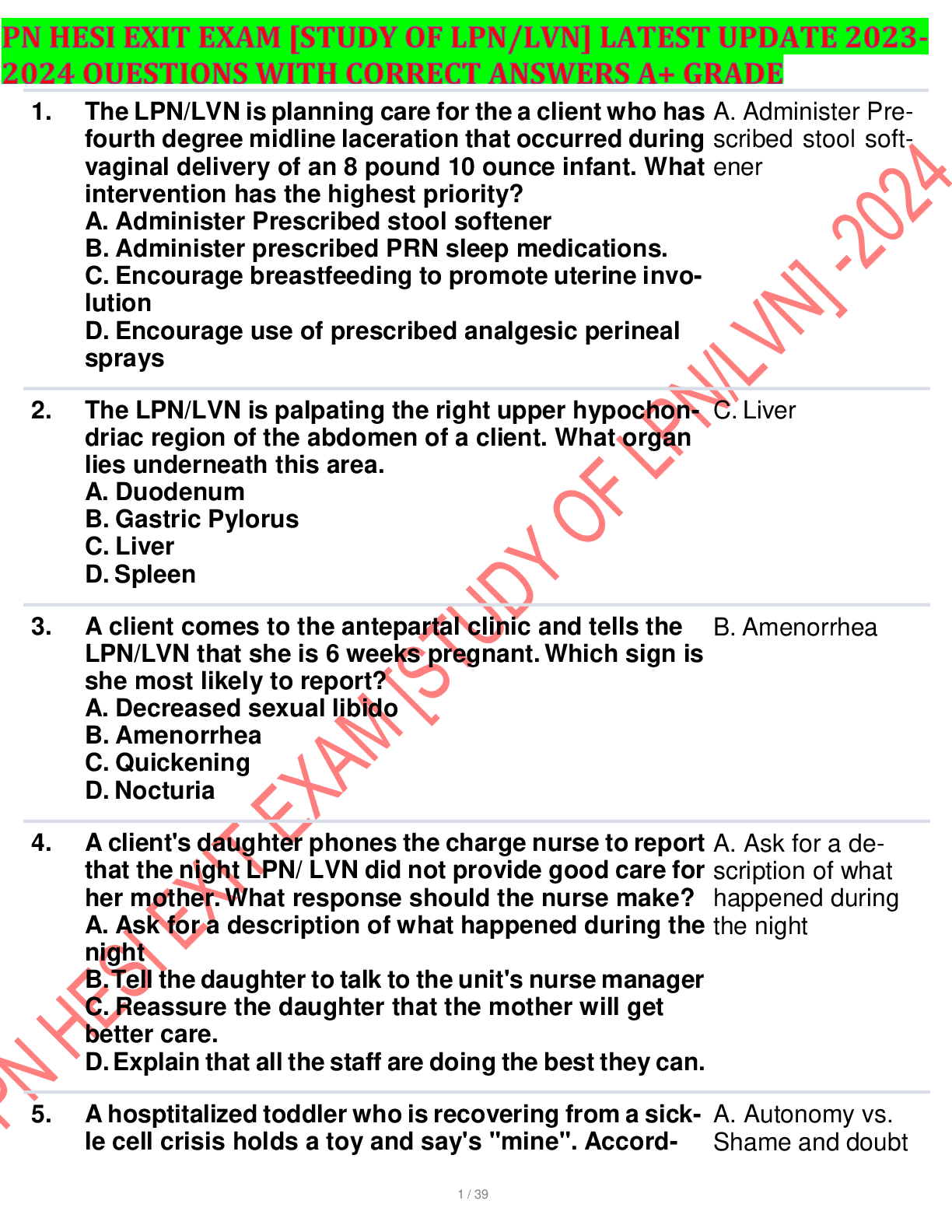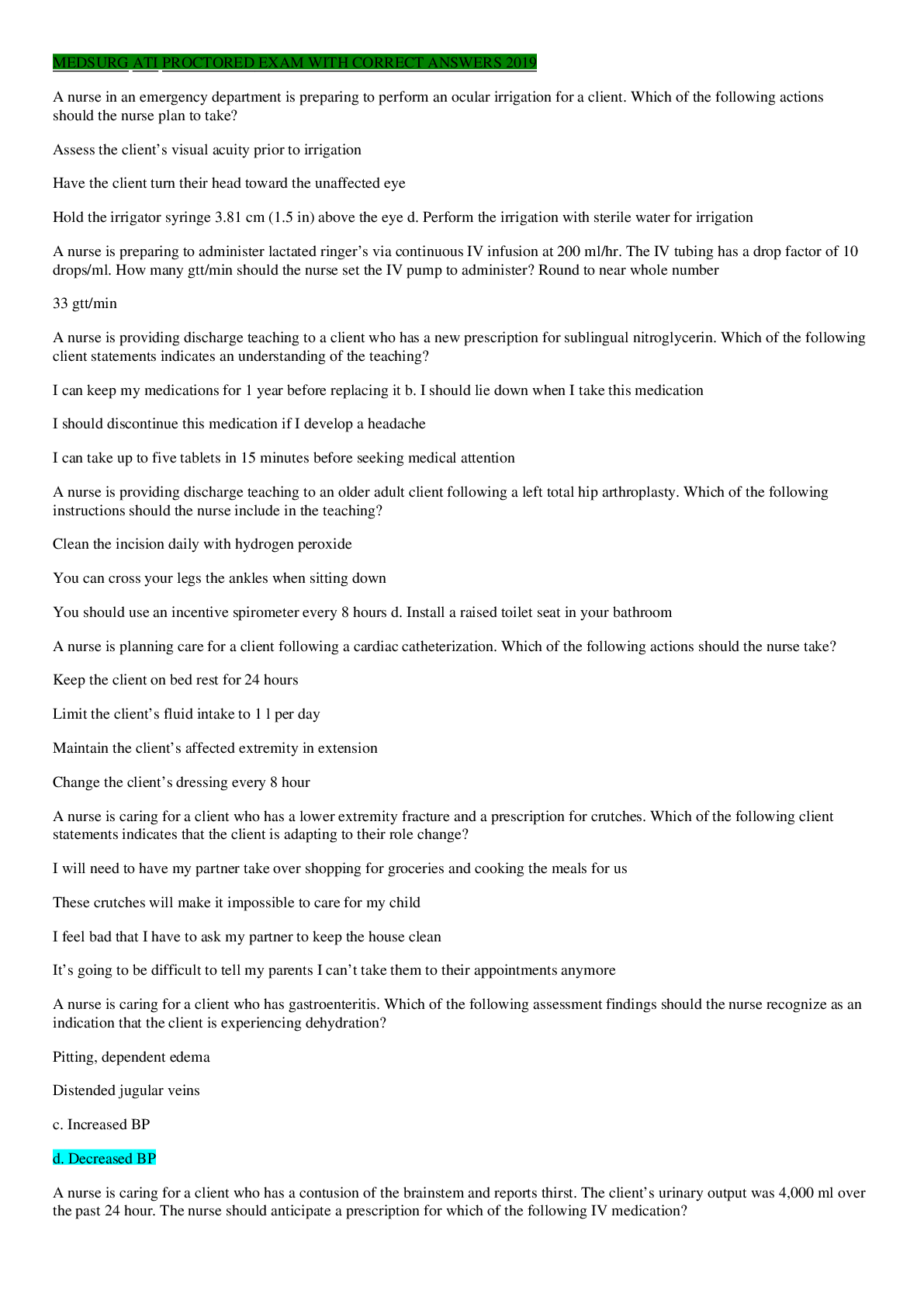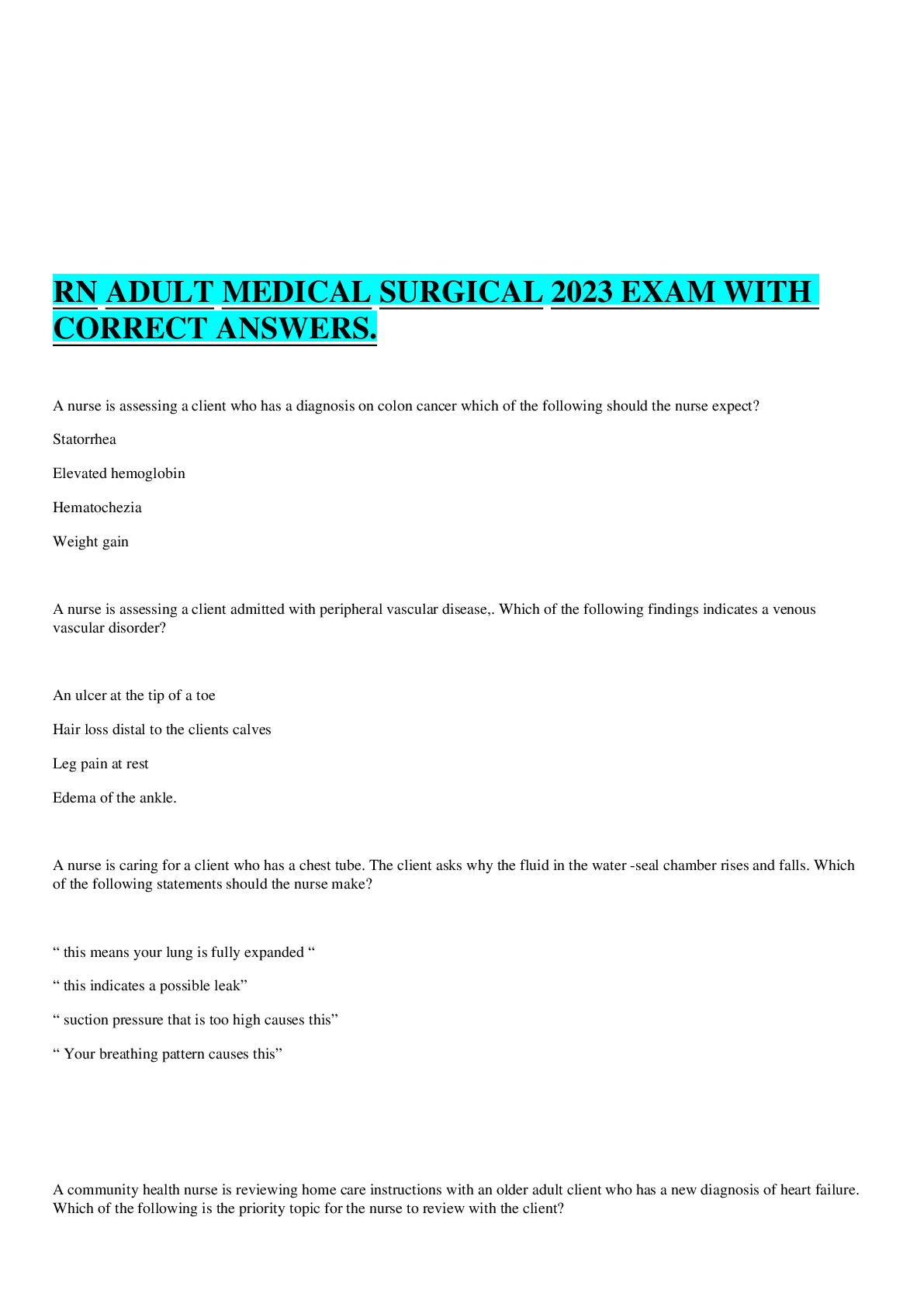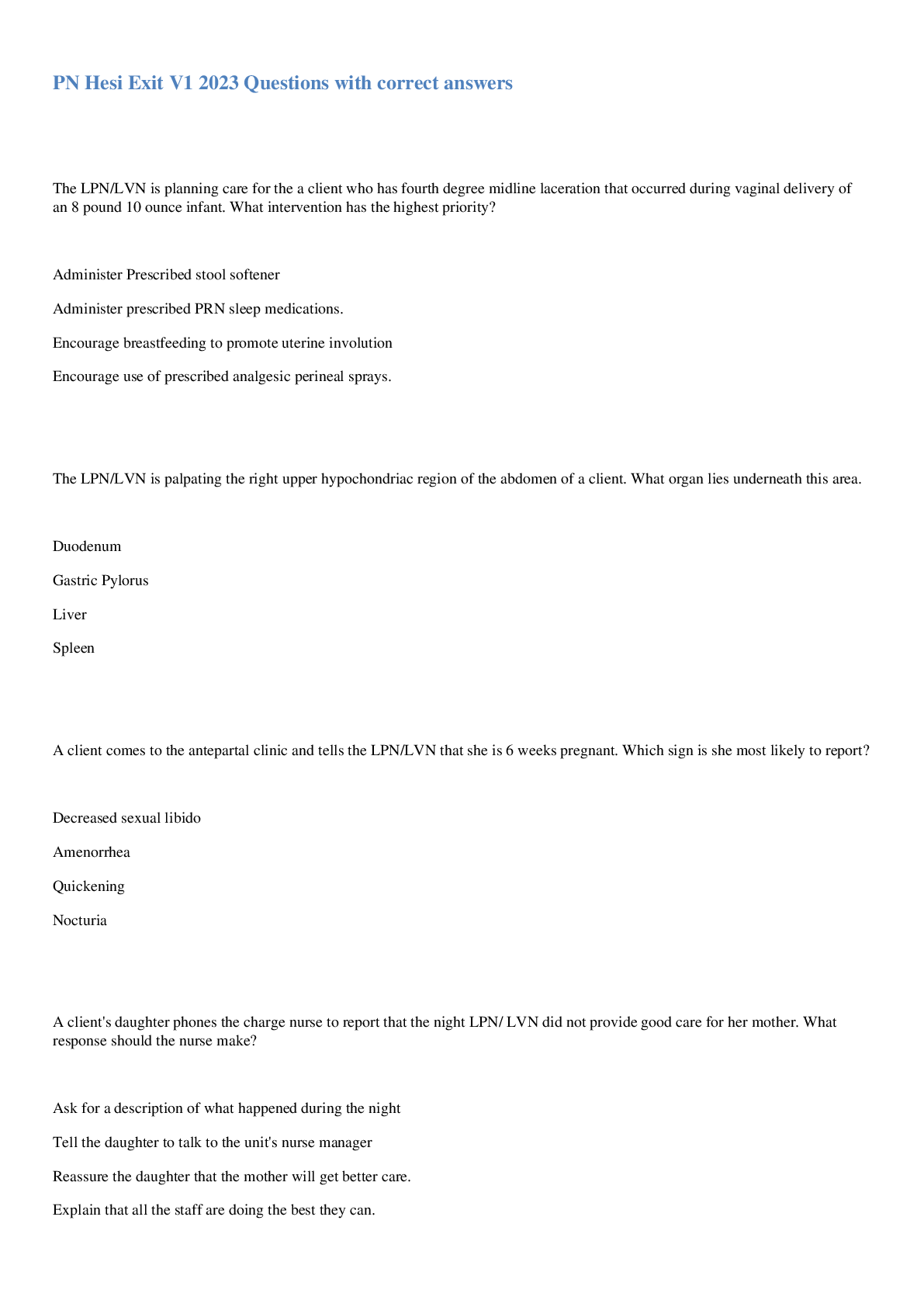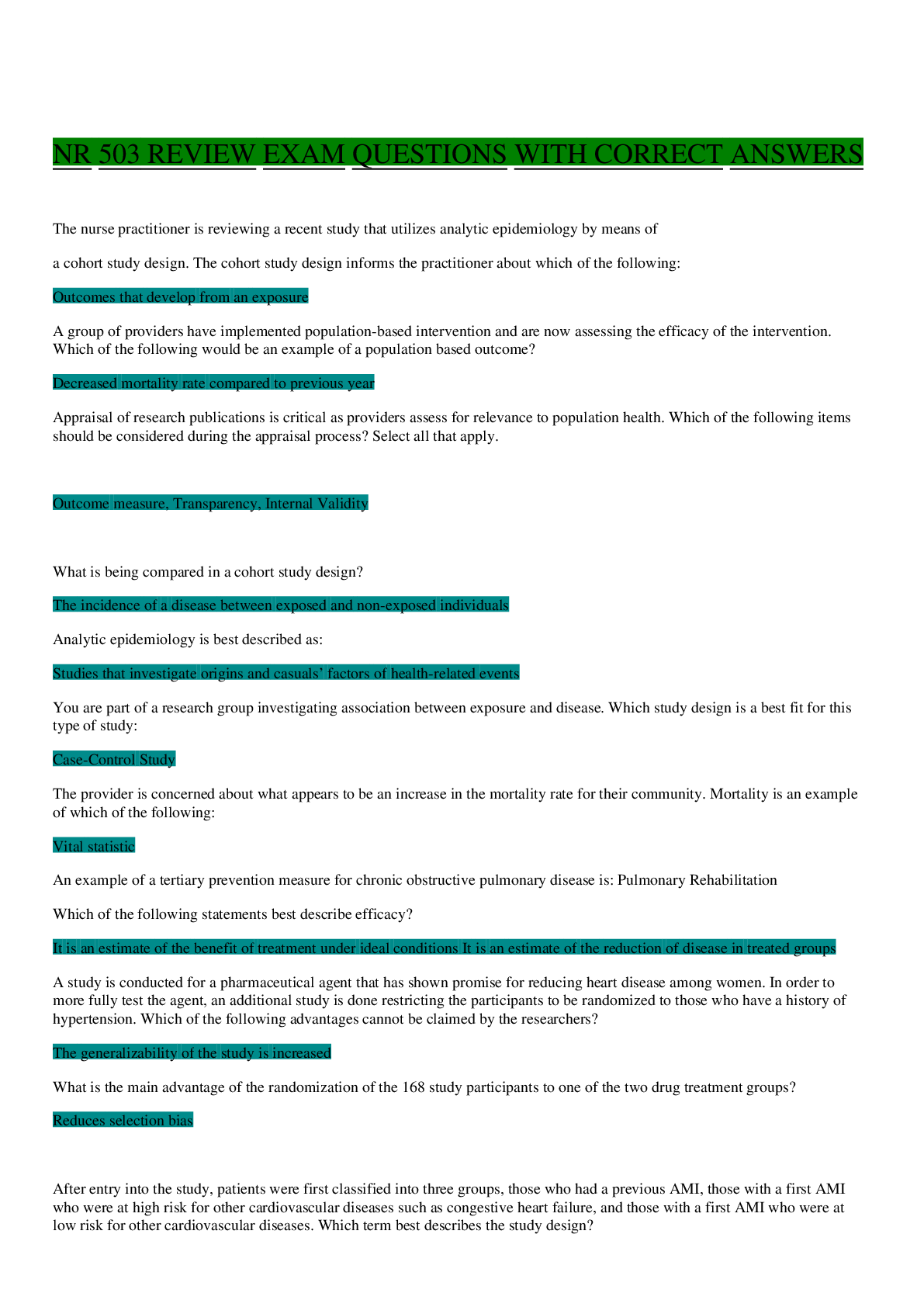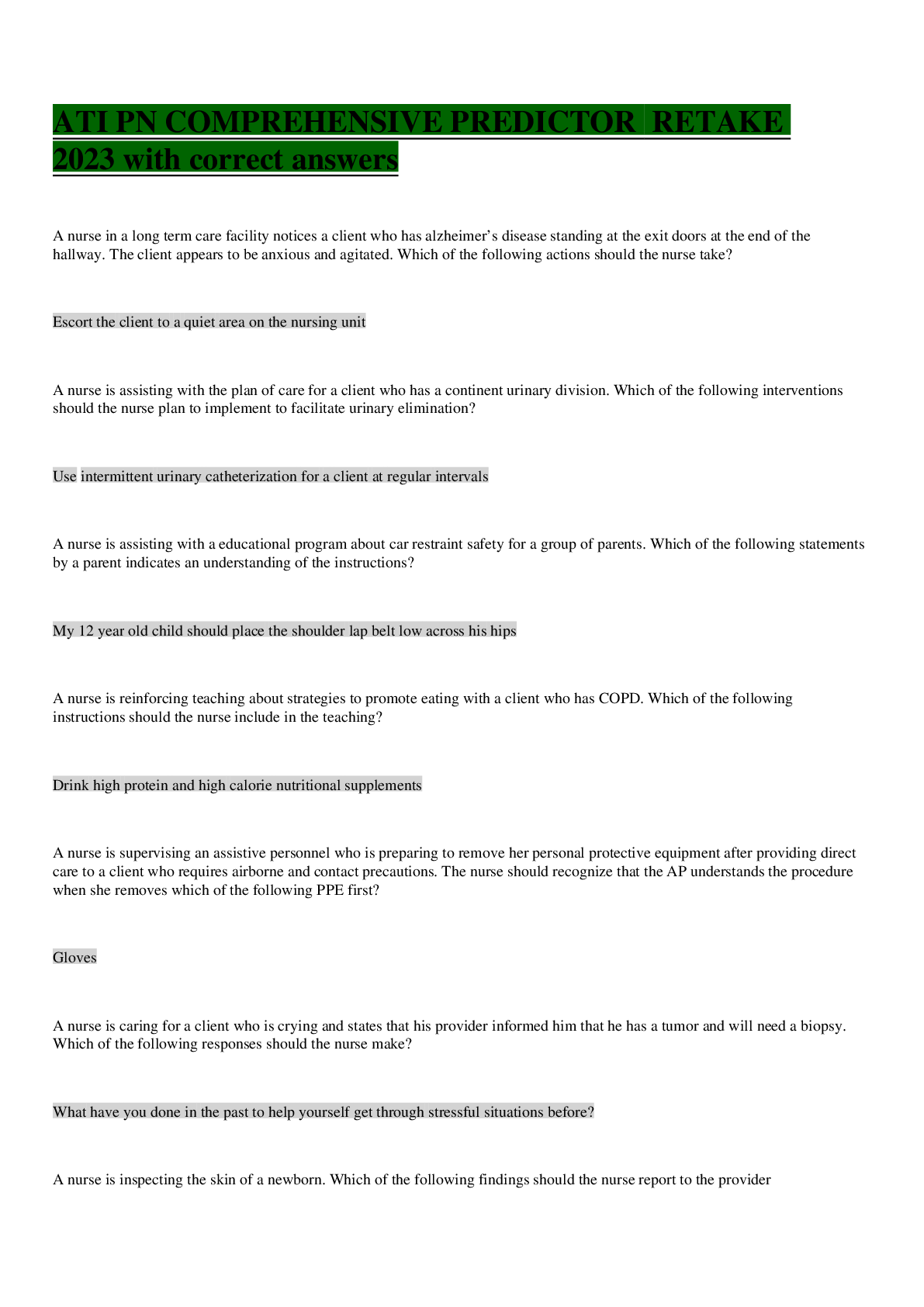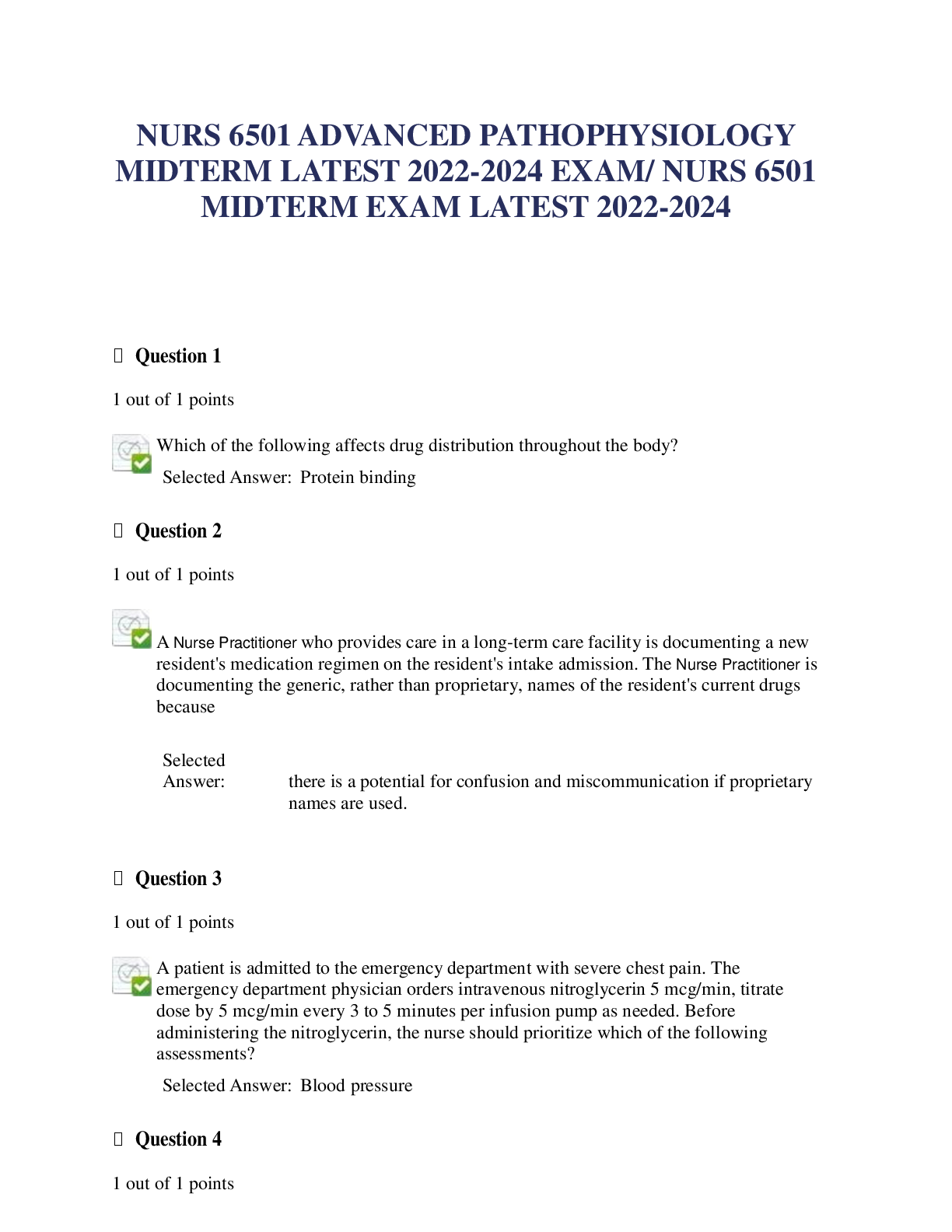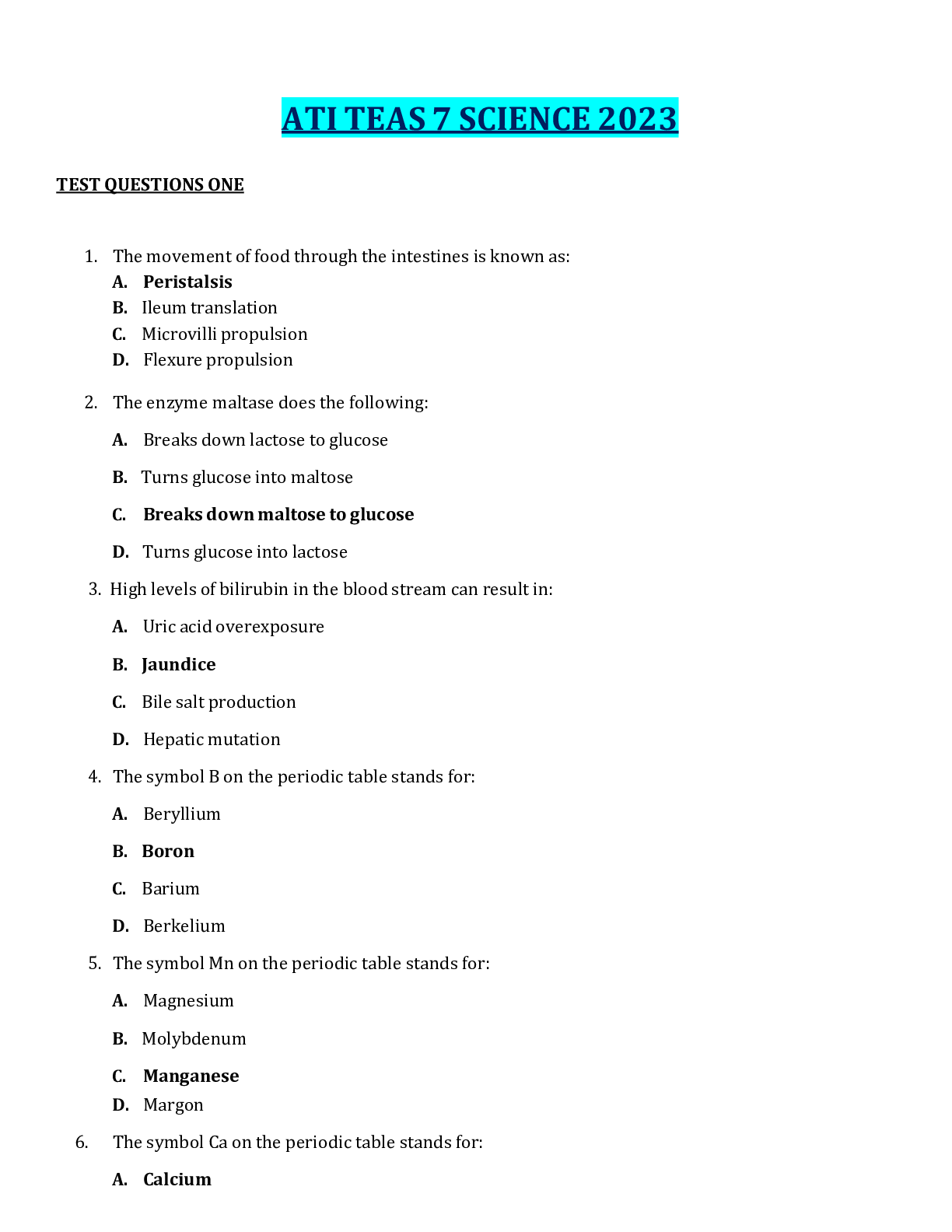Geriatrics, Alzheimer's, Dementia Practice Questions with correct Answers
Document Content and Description Below
The most common form of dementia in older adults is: A. Lewy body dementia B. Vascular dementia C. Frontotemporal dementia D. Alzheimer's disease E. Organic brain syndrome - ANSWER D Environ... mental risk factors for AD include: A. High educational level B. Head injury C. Low body weight D. Increased brain size E. Increased physical activity - ANSWER B Genetic susceptibility to late-onset Alzheimer's disease (AD) is primarily linked to: A. Presenilin gene mutations B. Amyloid precursor protein mutations C. Apolipoprotein E4 genotype D. Apolipoportien E2 genotype E. Angiotension-converting enzyme gene mutations - ANSWER C Is the following statement true or false? Diabetes increases the risk of AD. A. True B. False - ANSWER A The diagnostic workup for AD should include: A. A spinal tap to test the cerebrospinal fluid for the presence of -amyloid peptide fragments B. A CT scan to visualize neuritic plaques in the brain C. Blood tests to rule out vitamin D deficiency D. Biopsy of brain tissue to visualize neurofibrillary tangles E. Thyroid function tests to rule out hypothyroidism - ANSWER E J.F. is an 87-year-old man who was recently diagnosed with probable Alzheimer's disease. His Mini-Mental Status Examination (MMSE) score is 22, and his symptoms became noticeable approximately 1 year prior to the diagnosis. J.F.'s chief complaint is difficulty with his memory. He is able to perform all activities of daily living, and his care is not a burden to his wife. He exhibits no behavioral disturbances but does seem depressed. For patients such as J.F., which of the following drugs or drug combinations have been shown in multiple, double-blind, placebo-controlled trials to be effective therapy for mild to moderate AD? A. Gingko 120 mg twice daily B. Donepezil 10 mg daily plus memantine 10 mg twice daily C. Memantine 10 mg twice daily D. Vitamin E 1,000 international units twice daily E. Rivastigmine 3 mg twice daily - ANSWER E Alzheimer's disease is caused by: A. Amyloid plaques in the brain B. Neurofibrillary tangles in the brain C. Inflammatory processes in the brain D. Oxidative stress E. The cause of Alzheimer's disease is unknown. - ANSWER E QUESTION 1: CORRECT (You correctly answered D) The most common form of dementia in older adults is: A. Lewy body dementia B. Vascular dementia C. Frontotemporal dementia D. Alzheimer's disease E. Organic brain syndrome Related Topics: - alzheimer's disease - dementia QUESTION 2: CORRECT (You correctly answered B) Environmental risk factors for AD include: A. High educational level B. Head injury C. Low body weight D. Increased brain size E. Increased physical activity Related Topics: - alzheimer's disease QUESTION 3: CORRECT (You correctly answered C) Genetic susceptibility to late-onset Alzheimer's disease (AD) is primarily linked to: A. Presenilin gene mutations B. Amyloid precursor protein mutations C. Apolipoprotein E4 genotype D. Apolipoportien E2 genotype E. Angiotension-converting enzyme gene mutations Related Topics: - alzheimer's disease QUESTION 4: CORRECT (You correctly answered A) Is the following statement true or false? Diabetes increases the risk of AD. A. True B. False Related Topics: - alzheimer's disease QUESTION 5: CORRECT (You correctly answered E) The diagnostic workup for AD should include: A. A spinal tap to test the cerebrospinal fluid for the presence of -amyloid peptide fragments B. A CT scan to visualize neuritic plaques in the brain C. Blood tests to rule out vitamin D deficiency D. Biopsy of brain tissue to visualize neurofibrillary tangles E. Thyroid function tests to rule out hypothyroidism Related Topics: - alzheimer's disease QUESTION 6: INCORRECT (You answered B; the correct answer is E) J.F. is an 87-year-old man who was recently diagnosed with probable Alzheimer's disease. His Mini-Mental Status Examination (MMSE) score is 22, and his symptoms became noticeable approximately 1 year prior to the diagnosis. J.F.'s chief complaint is difficulty with his memory. He is able to perform all activities of daily living, and his care is not a burden to his wife. He exhibits no behavioral disturbances but does seem depressed. For patients such as J.F., which of the following drugs or drug combinations have been shown in multiple, double-blind, placebo-controlled trials to be effective therapy for mild to moderate AD? A. Gingko 120 mg twice daily B. Donepezil 10 mg daily plus memantine 10 mg twice daily C. Memantine 10 mg twice daily D. Vitamin E 1,000 international units twice daily E. Rivastigmine 3 mg twice daily Related Topics: - alzheimer's disease - rivastigmine QUESTION 7: CORRECT (You correctly answered E) Alzheimer's disease is caused by: A. Amyloid plaques in the brain B. Neurofibrillary tangles in the brain C. Inflammatory processes in the brain D. Oxidative stress E. The cause of Alzheimer's disease is unknown. Related Topics: - alzheimer's disease QUESTION 8: CORRECT (You correctly answered B) Which of the following statements is true regarding use of antipsychotics in patients with AD? A. Antipsychotics have a labeled indication for the treatment of behavioral disturbances in patients with AD. B. Antipsychotics are associated with an increased risk of death in dementia patients. C. Antipsychotics are first-line treatment for memory enhancement in patients with AD. D. Management of wandering behavior in patients with AD frequently requires the use of antipsychotics. E. Antipsychotics should not be used in the management of behavioral disturbances in patients with AD. - ANSWER B J.F. is an 87-year-old man who was recently diagnosed with probable Alzheimer's disease. His-Mini Mental Status Examination (MMSE) score is 22, and his symptoms became noticeable approximately 1 year prior to the diagnosis. J.F.'s chief complaint is difficulty with his memory. He is able to perform all activities of daily living, and his care is not a burden to his wife. He exhibits no behavioral disturbances but does seem depressed. In clinical situations similar to that of J.F., what should patients and families be told about clinical expectations from cholinesterase inhibitor therapy? A. Drug therapy will usually halt disease progression, and memory should significantly improve. B. The time to reach significant functional decline can be delayed, but behavioral disturbances usually worsen. C. The time to reach significant functional decline can be delayed, but the disease will continue to progress. D. Memantine is more effective than cholinesterase inhibitors for patients with mild to moderate AD. E. The risk of adverse events from cholinesterase inhibitors outweighs their usefulness in mild disease, and drug therapy should be delayed until the disease is moderately severe. - ANSWER C A.Y. is a 69-year-old white male who was recently diagnosed with Alzheimer's disease by his primary care physician. A.Y. also suffers from hypertension and hypercholesterolemia and has received treatment for these conditions for more than 5 years. A.Y.'s wife brought him in to see the primary care physician because he was becoming increasingly forgetful and suspicious. He experienced several bouts of agitation with aggressive behavior during the month before he was diagnosed with dementia. His primary care physician initiated galantamine therapy at the usual starting dose of 4 mg twice a day with food. Important counseling points for patients such as A.Y. starting cholinesterase inhibitors include: A. Therapy is usually short-term until the symptoms are controlled. B. A slow dose titration over 4 to 6 weeks is necessary to minimize side effects. C. The most common side effect of cholinesterase inhibitors is dry mouth. D. Significant improvement in memory is expected with galantamine therapy. E. Galantamine is expected to worsen A.Y.'s agitation. - ANSWER B What is the preferred initial treatment for most behavioral disturbances in AD? A. Benzodiazepines B. Anticonvulsants C. Antipsychotics D. Antidepressants E. Nonpharmacologic behavioral therapies - ANSWER E A.Y. is a 69-year-old white male who was recently diagnosed with Alzheimer's disease by his primary care physician. A.Y. also suffers from hypertension and hypercholesterolemia and has received treatment for these conditions for more than 5 years. A.Y.'s wife brought him in to see the primary care physician because he was becoming increasingly forgetful and suspicious. He experienced several bouts of agitation with aggressive behavior during the month before he was diagnosed with dementia. His primary care physician initiated galantamine therapy at the usual starting dose of 4 mg twice a day with food. A.Y.'s wife asks about using acetaminophen-diphenhydramine (Tylenol PM) to help her husband sleep. What recommendations should you give A.S. concerning the use of Tylenol PM? A. Diphendydramine is preferred over prescription medications to treat insomnia in the elderly. B. Diphenhydramine should be avoided because it is anticholinergic and can counteract the effects of galantamine. C. Diphenhydramine should be avoided because it increases blood sugar in the elderly. D. A.Y. should take diphenhydramine nightly until the symptoms of insomnia resolve. E. Diphenhydramine can enhance the effects of galantamine, so concurrent use should be avoided - ANSWER B K.L. is an 88-year-old woman who was diagnosed with Alzheimer's disease 8 years ago. She has been treated with donepezil 10 mg/day since she was first diagnosed. Her MMSE score today is 10, and her memory has declined significantly in the past 3 months. Appropriate therapy recommendations for K.L. include: A. The dose of donepezil should be increased to 20 mg/day B. Galantamine should be added to her current therapy. C. Memantine should be added to her current therapy. D. Donepezil is no longer effective and should be discontinued. E. No changes should be made in her drug therapy. - ANSWER C Is the following statement true or false? Cholinesterase inhibitors are indicated for the treatment of mild cognitive impairment. A. True B. False - ANSWER B Ginkgo: A. Is one of the most commonly used dietary supplements for the treatment of AD B. Should be taken with vitamin E for optimal efficacy C. Is recommended for use primarily in late-stage AD D. Is safe for use in patients with vascular dementia and atrial fibrillation taking warfarin E. Products are standardized with regard to content and consistency - ANSWER A [Show More]
Last updated: 1 year ago
Preview 1 out of 7 pages
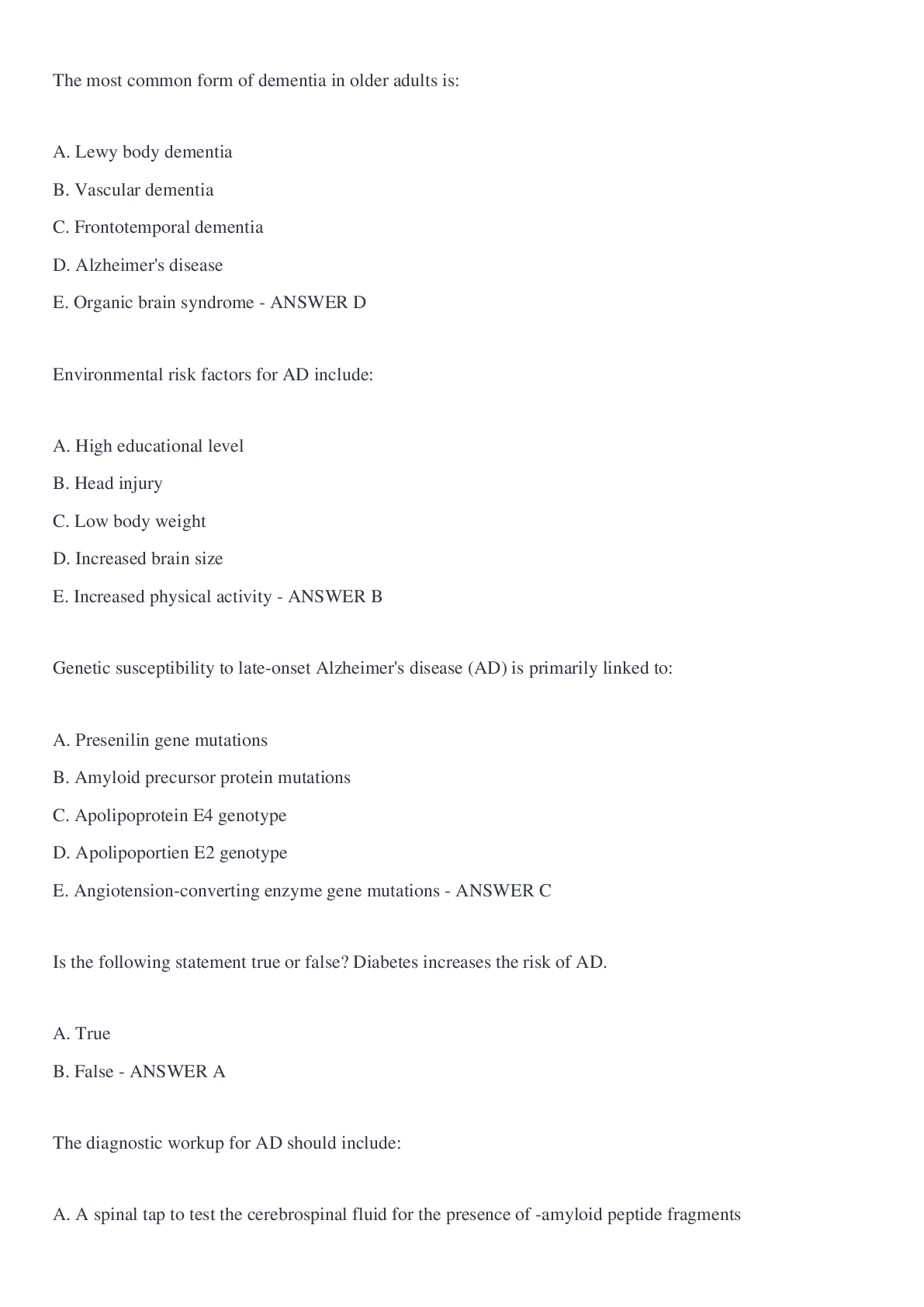
Reviews( 0 )
Document information
Connected school, study & course
About the document
Uploaded On
Jul 28, 2022
Number of pages
7
Written in
Additional information
This document has been written for:
Uploaded
Jul 28, 2022
Downloads
0
Views
27

